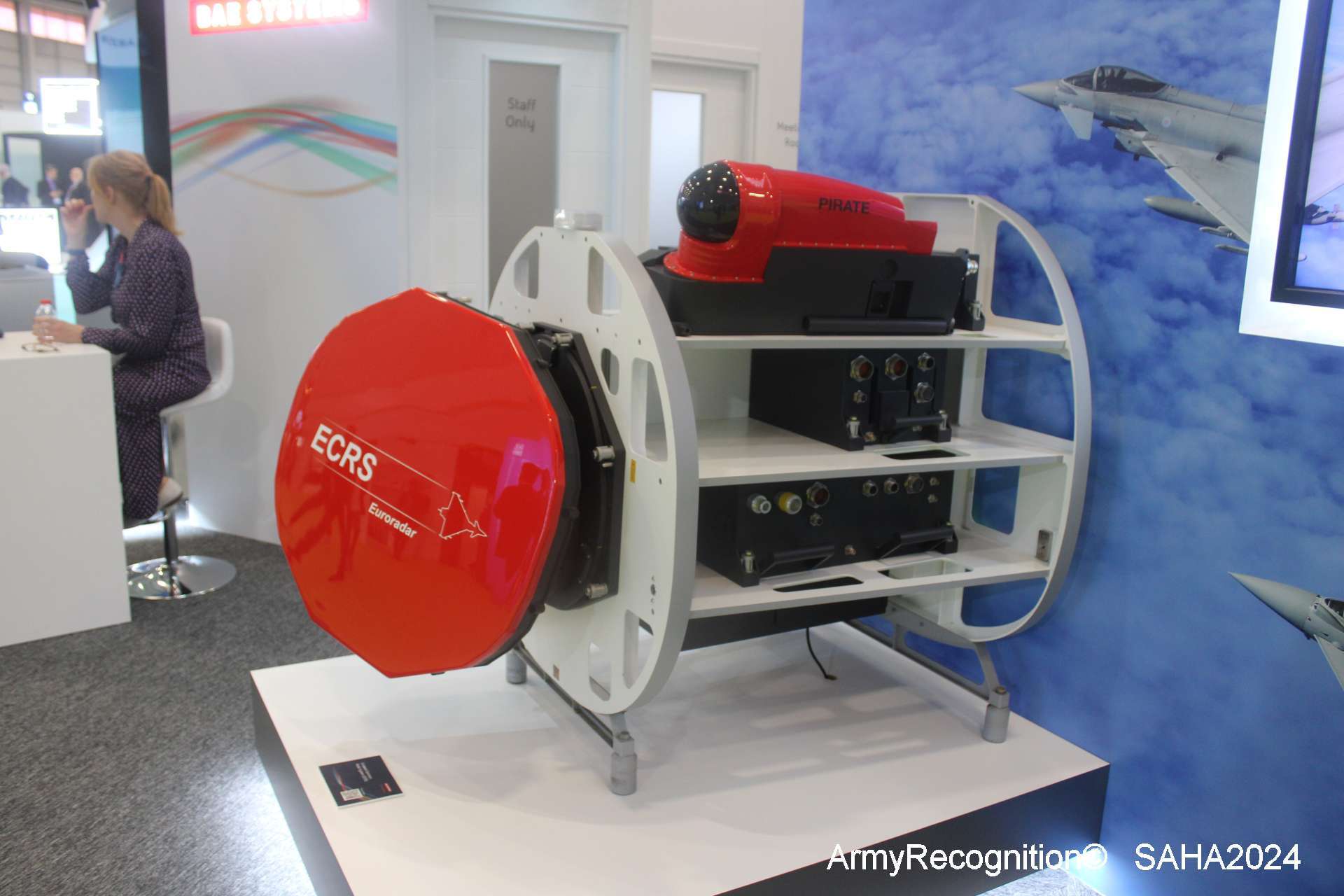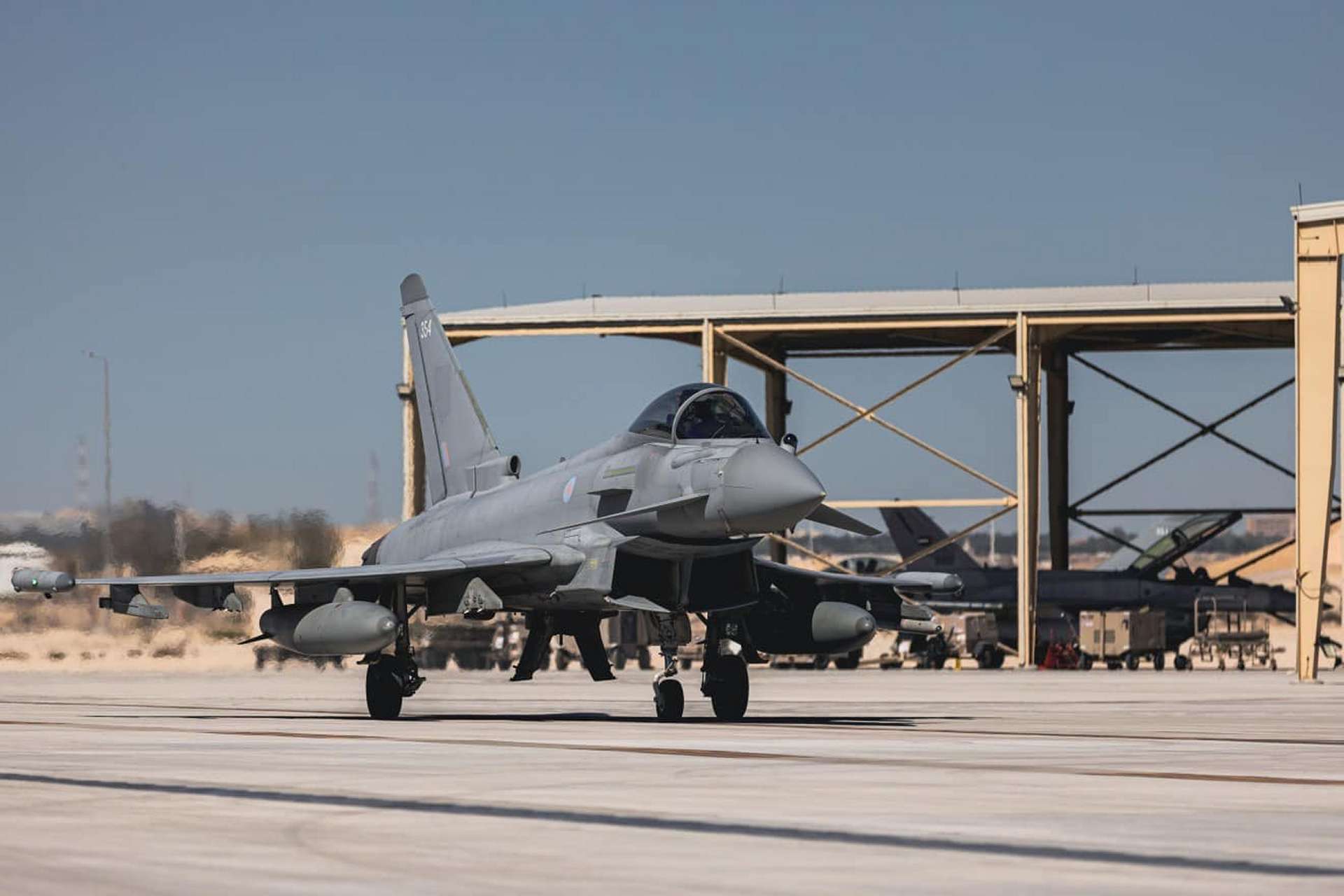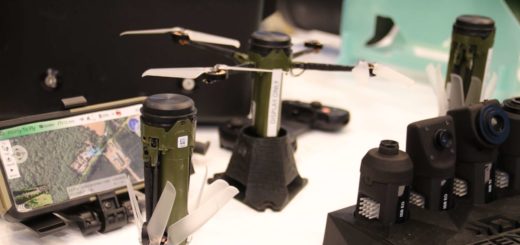BAE Systems offers to upgrade Eurofighter Typhoon fighter jet for Türkiye with electronic warfare capabilities

{loadposition bannertop}
{loadposition sidebarpub}
At the SAHA 2024 exhibition, BAE Systems presented the European Common Radar System (ECRS), which is under consideration for integration into the Eurofighter Typhoon. Türkiye has expressed interest in incorporating the ECRS radar into its fleet as part of efforts to strengthen its air combat capabilities. The ECRS is an Active Electronically Scanned Array (AESA) radar, designed to enhance detection, tracking, and electronic warfare functions compared to older radar systems.Follow Army Recognition on Google News at this link
Both the Mk0 and Mk2 variants of the ECRS radar use AESA technology based on solid-state Transmit/Receive Modules (TRMs), which allows for more precise radar beam control, enabling aircrews to detect, track, and engage targets at longer distances. (Picture source: Army Recognition)
The ECRS Mk0 is the first AESA radar developed for the Eurofighter Typhoon. Created by Leonardo UK as part of the EuroRadar consortium, it represents an upgrade from the older Captor-M mechanically scanned radar. The Mk0 radar allows for simultaneous tracking of multiple targets, improving operational efficiency and situational awareness across various missions. AESA technology enables more precise control of radar beams, offering improved detection range and accuracy, particularly in challenging combat conditions.
Leonardo is also developing the ECRS Mk2, an advanced version of the radar, in collaboration with the UK Ministry of Defence. The Mk2 variant aims to further extend the system’s capabilities, with a particular focus on electronic warfare and electronic attack functions. It is designed to enhance the Eurofighter Typhoon’s performance in both air-to-air and air-to-ground missions. The Mk2 incorporates hardware and software upgrades that improve electronic countermeasures and target detection.
Both the Mk0 and Mk2 variants of the ECRS radar use AESA technology based on solid-state Transmit/Receive Modules (TRMs). This technology allows for more precise radar beam control, enabling aircrews to detect, track, and engage targets at longer distances. AESA radars also provide greater operational flexibility, supporting multiple operational modes and maintaining performance in environments with high levels of interference. These radars are resistant to electronic jamming, a critical feature in modern combat.
Türkiye is currently in negotiations to purchase 40 Eurofighter Typhoon fighter jets from the Eurofighter consortium, which includes Germany, the UK, Spain, and Italy. Recently, Germany approved technical negotiations after initial hesitation. This potential acquisition aligns with Türkiye’s broader goals to modernize its air force, driven by regional challenges and geopolitical factors. The Eurofighter Typhoon is viewed as an interim solution as Türkiye continues to develop its indigenous fighter, the KAAN.
The Eurofighter Typhoon is viewed as an interim solution as Türkiye continues to develop its indigenous fighter, the KAAN. (Picture source: Eurofighter)
Negotiations for this deal have gained momentum, partly due to Türkiye’s difficulties in securing F-16 upgrades from the U.S., following its purchase of the S-400 air defense system from Russia. If completed, the Eurofighter deal, valued between €8 billion and €10 billion, would strengthen Türkiye’s NATO role and help maintain air superiority in regions like the Eastern Mediterranean. This acquisition would also reduce Türkiye’s reliance on U.S. military systems, as the country was excluded from the F-35 program after its S-400 purchase.
If Türkiye proceeds with integrating the ECRS radar into its Eurofighter Typhoon fleet, it could significantly enhance the air force’s combat capabilities. The AESA radar’s capacity for detecting and tracking targets at extended ranges, along with its electronic warfare capabilities, would support a variety of combat operations. The radar’s modular design also allows for future upgrades, ensuring it remains adaptable to emerging threats and technologies.
The ECRS Mk2 variant would offer further advantages for the Eurofighter Typhoon, particularly in situational awareness and electronic warfare. This radar can detect, track, and engage multiple air and ground targets simultaneously, which is especially relevant in high-intensity operations. The Mk2’s electronic warfare functions also include jamming and disrupting enemy radar and communications, assisting in countering air defense systems and improving the aircraft’s survivability.
The ECRS Mk2’s multifunctional capabilities allow it to perform several tasks simultaneously. For example, the radar can continue detecting ground-based threats or jamming enemy systems while engaging in air-to-air combat. If equipped with the ECRS, the Typhoons could bring enhanced situational awareness, electronic warfare functions, and adaptability to future technological developments, supporting Türkiye’s ability to address modern combat requirements.

{loadposition bannertop}
{loadposition sidebarpub}
At the SAHA 2024 exhibition, BAE Systems presented the European Common Radar System (ECRS), which is under consideration for integration into the Eurofighter Typhoon. Türkiye has expressed interest in incorporating the ECRS radar into its fleet as part of efforts to strengthen its air combat capabilities. The ECRS is an Active Electronically Scanned Array (AESA) radar, designed to enhance detection, tracking, and electronic warfare functions compared to older radar systems.
Follow Army Recognition on Google News at this link
Both the Mk0 and Mk2 variants of the ECRS radar use AESA technology based on solid-state Transmit/Receive Modules (TRMs), which allows for more precise radar beam control, enabling aircrews to detect, track, and engage targets at longer distances. (Picture source: Army Recognition)
The ECRS Mk0 is the first AESA radar developed for the Eurofighter Typhoon. Created by Leonardo UK as part of the EuroRadar consortium, it represents an upgrade from the older Captor-M mechanically scanned radar. The Mk0 radar allows for simultaneous tracking of multiple targets, improving operational efficiency and situational awareness across various missions. AESA technology enables more precise control of radar beams, offering improved detection range and accuracy, particularly in challenging combat conditions.
Leonardo is also developing the ECRS Mk2, an advanced version of the radar, in collaboration with the UK Ministry of Defence. The Mk2 variant aims to further extend the system’s capabilities, with a particular focus on electronic warfare and electronic attack functions. It is designed to enhance the Eurofighter Typhoon’s performance in both air-to-air and air-to-ground missions. The Mk2 incorporates hardware and software upgrades that improve electronic countermeasures and target detection.
Both the Mk0 and Mk2 variants of the ECRS radar use AESA technology based on solid-state Transmit/Receive Modules (TRMs). This technology allows for more precise radar beam control, enabling aircrews to detect, track, and engage targets at longer distances. AESA radars also provide greater operational flexibility, supporting multiple operational modes and maintaining performance in environments with high levels of interference. These radars are resistant to electronic jamming, a critical feature in modern combat.
Türkiye is currently in negotiations to purchase 40 Eurofighter Typhoon fighter jets from the Eurofighter consortium, which includes Germany, the UK, Spain, and Italy. Recently, Germany approved technical negotiations after initial hesitation. This potential acquisition aligns with Türkiye’s broader goals to modernize its air force, driven by regional challenges and geopolitical factors. The Eurofighter Typhoon is viewed as an interim solution as Türkiye continues to develop its indigenous fighter, the KAAN.

The Eurofighter Typhoon is viewed as an interim solution as Türkiye continues to develop its indigenous fighter, the KAAN. (Picture source: Eurofighter)
Negotiations for this deal have gained momentum, partly due to Türkiye’s difficulties in securing F-16 upgrades from the U.S., following its purchase of the S-400 air defense system from Russia. If completed, the Eurofighter deal, valued between €8 billion and €10 billion, would strengthen Türkiye’s NATO role and help maintain air superiority in regions like the Eastern Mediterranean. This acquisition would also reduce Türkiye’s reliance on U.S. military systems, as the country was excluded from the F-35 program after its S-400 purchase.
If Türkiye proceeds with integrating the ECRS radar into its Eurofighter Typhoon fleet, it could significantly enhance the air force’s combat capabilities. The AESA radar’s capacity for detecting and tracking targets at extended ranges, along with its electronic warfare capabilities, would support a variety of combat operations. The radar’s modular design also allows for future upgrades, ensuring it remains adaptable to emerging threats and technologies.
The ECRS Mk2 variant would offer further advantages for the Eurofighter Typhoon, particularly in situational awareness and electronic warfare. This radar can detect, track, and engage multiple air and ground targets simultaneously, which is especially relevant in high-intensity operations. The Mk2’s electronic warfare functions also include jamming and disrupting enemy radar and communications, assisting in countering air defense systems and improving the aircraft’s survivability.
The ECRS Mk2’s multifunctional capabilities allow it to perform several tasks simultaneously. For example, the radar can continue detecting ground-based threats or jamming enemy systems while engaging in air-to-air combat. If equipped with the ECRS, the Typhoons could bring enhanced situational awareness, electronic warfare functions, and adaptability to future technological developments, supporting Türkiye’s ability to address modern combat requirements.





